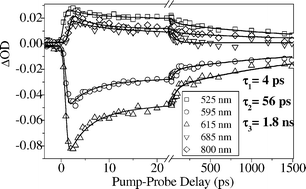Blepharisma japonicum is a ciliated protozoan exhibiting a strong step-up photophobic response upon illumination. The photoreceptor chromophores responsible for this response have been identified to be hypericin-like chromophores (blepharismin and oxyblepharismin), complexed to a 200 kDa non-water-soluble protein. The present work opens up new perspectives on the primary phototransduction steps of B. japonicum's light perception through a joined approach by steady-state fluorescence spectroscopy, time-resolved fluorescence anisotropy and sub-picosecond transient absorption spectroscopy. The free chromophore of the light-adapted form of the cell (oxyblepharismin) was studied in various solvents and its spectroscopic properties, as well as its primary excited-state reactivity, compared with those of the corresponding pigment–protein complex, extracted by phosphate-concentration-step chromatography on a hydroxyapatite column. Fluorescence anisotropy together with SDS PAGE electrophoresis results confirm that oxyblepharismin is non-covalently bound to the apoprotein and show that, in the excited state, it is free to rotate in all directions within the binding site where it experiences a large local viscosity. Time-resolved anisotropy measurements on aromatic amino acids confirm that the molecular weight of the protein is of the order of 200 kDa. Although showing very similar steady-state spectra, free oxyblepharismin and its protein complex have noticeably different excited-state behaviours. In particular, the protein complex exhibits a pronounced short-lived absorption feature in the 640–750 nm range, decaying biexponentially in 4 ps and 56 ps. Those decays, also observed in other spectral regions, are not found in the corresponding kinetics of the isolated pigment in solution. This early behaviour of the protein complex might be the signature of the primary phototransduction process, possibly involving an electron transfer from the pigment to a neighbouring protein acceptor residue as it had been suggested in previous studies.

You have access to this article
 Please wait while we load your content...
Something went wrong. Try again?
Please wait while we load your content...
Something went wrong. Try again?


 Please wait while we load your content...
Please wait while we load your content...